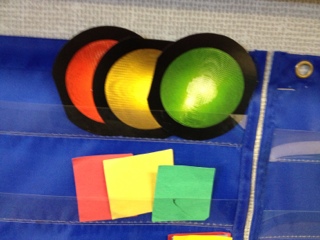The classroom rug is a learning environment within a learning environment. It is the best place for strategic partner talk in Kindergarten, First Grade, and Second Grade. The importance of the seating chart on the classroom rug plays a big role in classroom management here. Once I have students in the second and fourth row facing their partner, I pass out "Talking Sticks." They are pictured below. The idea came from a book called, "
Structured Language Practice." In our district, we nicknamed all the wonderful strategies in the book as "slips." (More on that later)
 |
| Talking Stick - Structured Language Practice |
I chose to add a parrot sticker on purpose because parrots talk a lot! A monkey stick will do the trick too! These popsicle sticks have stickers on the end and they are all the same. The cup contains 12 sticks; one for each pair of kids. The rule is that only the child holding the talking stick may speak. The other partners must quietly listen. This ensures that children are also listening to their classmate. After a few seconds I ring the bell and that is their cue to pass the talking stick.
Yet another version of talking stick is plastic microphones from a local dollar store or the dollar bins at Target. Same rules, different realia. I like to keep things different for my kinders. To them the slightest change is like a whole new ballgame.
 |
Kindergarten Partner Talk -
Plastic Microphones |
Besides the trusty, "Turn to face your partner" trick, there are other ways to group children for partner talk that don't involve the carpet seating chart. Here are the contents of the other cup, my Chargers cup. (Can you tell I'm from San Diego?)
 |
| Partner Talk - Select a partner by matching the sticker |
It contains 24 foam popsicle sticks. Each foam popsicle stick has a sticker on the end. The matching stick is the same color and has the same sticker as well. To assign RANDOM partners, I hold the cup up above the head of each child so they can't see inside the cup and have them select a stick. After each child has pulled a stick I give the class 1 minute to find their partner and sit together. If you can get all three of the above you'll be
good to go when it comes to partner talk.
Covers! Yet another way to sort Kindergarten students into pairs is with thematic hats!
 |
Partner Talk in Kindergarten -
Thematic Hats with adjustable
elastic band and brads |
Like the foam partner sticks, students get one minute to find a partner and sit down together. You guessed it the flowers must pair up with the bees. No two bees may end up together nor two flowers. These adorable adjustable hats can be made out of any theme : frog and lilly pad, owl and tree, frog and insect, baby animal to adult animal, etc. I selectively choose who is allowed to be a bee and who is allowed to be a flower based on the homogenous ability (shape) groups shown in the prior post found
here. For example, Triangles (low) and Circles (focus) will be bees and Rectangles (high) and Squares (medium) will be flowers. This way, there is always a structure to the pairings. This avoids the ol'
Blind Leading the Blind scenario.
Here is an alternate to the hats I pictured above with flowers and bees. Match snails to leaves. Print out and glue to strips for a quick, easy alternative.
Update July 9th : I just returned from my local Dollar Tree store and found these 3 gems.
 |
| Partner Talk Cards (and Hats) |
Milk and cookies ! Ketchup and mustard! Cheese and Mice! So cute. I'm definitely going to make a new set of
covers out of the mice and cheese. However, I'm going to laminate and save the other two sets in their card format and pass them out by hand when I want to do partner talk activities. Hope you can make it out to Dollar Tree and snag these up too!















































